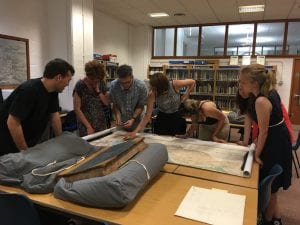Aidan Shilson-Thomas is one of our students who is capturing the rich history of the Temple Quarter site. Read his findings about how a 200-year old visitors book revealed the secrets of Bristol’s imperial past.

As part of the team tasked with researching the History of the site where the University’s Temple Campus will be built, our brief sometimes seemed overwhelming: ‘Find out about the people who lived and worked there’. Sounds simple enough?
The land around Bristol’s enterprise quarter has been farmed, worshipped on, industrialised, deindustrialised, developed and levelled time and again for over 1000 years. The campus will be a major development, but from a historical perspective it’s just another blip on Bristol’s map.
With such rich history we were faced with a true mountain of source material. The archival records ran to hundreds of ‘items’, and some of these were hundreds of pages long! It’s no surprise, therefore, that we sometimes chanced on the unexpected. When you don’t know exactly what you’re looking for, or even exactly what you’re looking at(!), the smallest detail can take you on a trip through the archives.
On the same land where part of the new campus will be built, 400 men, women, and children worked for John Hare & Co. in the 18th and 19th centuries, producing stunning decorative floorcloths that were sold around the world. A visitor’s log from the 1800s shows that people visited from as far away as Barbados, Cuba and New York.
Reading through the log, I had expected to see some international visitors. But an entry which took us all by surprise was for three signatures which had been marked as being from the sons of the King of Ashantee. What on earth were three African princes doing in a carpet factory in Bristol?
We learned that they weren’t there voluntarily. These princes were hostages to the British government after a treaty with the Ashantees broke down. Whilst in Britain, it was claimed that they had ‘greatly profited by care and attention bestowed upon their education; they [then] engaged in a tour through England to inspect the different manufactories…previous to their return to their native country.’
In light of this we re-examined another entry from an ‘Edward George Jenkinson, in service to the New Zealand government.’ Some digging revealed that Jenkinson was a translator who served the governor of New Zealand, and that he had brought 11 high-ranking Maoris to England in 1863 to teach them about British industry. This was, reported the Scotsman, so that they could ‘obtain such general information respecting the greatness and power of England as may prove a benefit to themselves and to their several tribes on their return…’
The Maori’s were also introduced to Christian leaders and visited the home of John Wesley. The Ashantee princes had received a similar treatment, and the papers reporting on their tour claimed that they had become ‘sincere and true converts’ to Christianity.
From these signatures we discovered a different history of the site to the one we’d been looking for. As a key manufacturing site, an exemplar of British industry and enterprise, John Hare & Co. became a means to carrying out the ‘civilising mission’. It was part of a process of religious and social indoctrination that was meant to acculturate not only the Ashantee princes and the Maori leaders, but also, eventually, the people who they ruled in Britain’s empire.
The history of the site of the new campus can give us a sense of perspective. The campus will be the next chapter in the site’s history, not the first. It was an ‘enterprise zone’ long before we decided to call it one! It also gives us fresh insights into the city that we all live and work in. Bristol has an intimate, complicated and problematic association with Empire. Our site’s history newly reveals one of the many ways that this was forged and reinforced.

